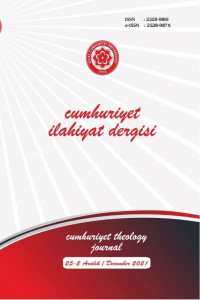Heterodoks Sûfîler Arasında Meçhul Bir İsmin İzini Sürmek: Sûfî Şair Çelebi Sultan’ın Kimliğini İnşâ Denemesi
Tracing An Unknown Name Among Heterodox Ṣūfīs: An Attempt to Build Ṣūfī Poet Chelebi (Çelebi) Sulṭān’s Identity
Author(s): Oğuzhan ŞahinSubject(s): Islam studies, Turkish Literature, 16th Century, 17th Century, Theory of Literature
Published by: Cumhuriyet Üniversitesi İlahyat Fakültesi
Keywords: Turkish Islamic Literature; Chelebi (Çelebi) Sulṭān; Sheikh İsmāʿil-i Maʿşūḳī; Eşrefoğlu Rūmī; Misālī; Ism-musemmā; Hurufism; Heterodox Ṣūfīs;
Summary/Abstract: Chelebi (Çelebi) Sulṭān is a Ṣūfī poet. Due to poor and limited sources, there is a hardness in finding accurate and sufficient information about him. Abdülbaki Gölpınarlı claimed that this anonymous poet could be Oğlan Sheikh İsmāʿil-i Maʿşūḳī (d. 1539) from Bayramī-Melāmī by relying on the unanimous ghazal recorded in Ḥālet Efendi 800 in Suleymaniye Library. However, the fact that the aforementioned ghazal with simple copy variations published in Eşrefoğlu Rūmī Diwan weakens the credibility of his argument that Chelebi Sulṭān could be Oğlan Sheikh İsmāʿil-i Maʿşūḳī. Though the acknowledgment of this data, Gölpınarlı still insisted on the credibility of his claim that the ghazal belongs to Oğlan Sheikh. Moreover he argued that the claims suggesting that the ghazal belongs to Eşrefoğlu Rūmī (d.1469) should be questioned. Other than this ghazal, there is one more qasida (ḳasīde) with having gizlidir word after the rhyme associate to Chelebi Sulṭān, and an annotation to this qasida by Āyīne-zāde Meḥmed Şemseddīn-i Sirozī (d. 1688/89). However, neither the qasida and ghazal attributed Chelebi Sulṭān nor the Āyīne-zāde’s annotation provide satisfying information to identify the identity of the poet. Therefore, it can be claimed that Chelebi Sulṭān’s identification is based on weak arguments. No more evidence can develop these estimations into evidence-based arguments. This article tries to provide a virtual framework for the identity of Chelebi Sulṭān. In this context, the article firstly discusses Chelebi Sulṭān’s disposition and popularity on Ṣūfī groups by considering the contents of the manuscripts mentioning him. Then, it analyzes whether Chelebi Sulṭān is associated with Ḥurūfīs or not by focusing on the ism-musemmā subject in the two first couplets of the qasida attributed to the Ṣūfī poet. Finally, the article speculates whether the poet called Chelebi Sulṭān in literature could be Misālī (d. 1577), or not, who is one of the Ḥurūfī poets. The subject of Chelebi Sulṭān's connection with Ḥurūfīsm is examined under two titles in the article. The possibility of Chelebi Sulṭān to be Misālī, one of the Ḥurūfī poets, was discussed based on the qasida with nedür rhyme. In this regard, there are two assumptions. The first one is that the pseudonym Misālī is mentioned in the qasida, and the second evidence is that there is a qasida with nedür word after rhyme belonging to Chelebi Sulṭān in the two copies of the Misālī Diwan. However, although the mentioned qasida exists in the recent copies, this qasida is not found in the oldest copies of the diwan. Therefore it is possible to conclude that this lack weakens the possibility that Chelebi Sulṭān could be Misālī, one of the Ḥurūfī poets. The second title is related to the issue of the ism-musemmā in the first two couplets of the qasida with nedür word after rhyme. Through this analysis, it was discussed whether Chelebi Sulṭān could be Ḥurūfī or not. At this point, it is revealed that there is a similarity between the two couplets of Chelebi Sulṭān in the qasida with nedür word after rhyme on the issue of ism-musemmā and some other couplets of Ḥurūfī poets (Nesīmī / Ḫalîlî, Misālī, et al.) on the same issue. Besides, the views of a few groups, apart from the Ḥurūfī Poets, that discussed ism-musemmā issue in their poetry, were evaluated. The article refers to the Ṣūfī poet's qasida with nedür word after rhyme while discussing the issue of which groups favored Chelebi Sulṭān more and it also tried to determine which groups read this qasida at that period. To discuss the general content of the manuscript, the manuscript registered in Suleymaniye Library Mihrisah Sultan number 185, the corpus cataloged in Suleymaniye Library, Galata Mevlevihanesi 233, and the manuscript cataloged in Millet Library Ali Emiri Collection (AEArb) 4341, were examined. Thus it can be claimed both Chelebi Sulṭān and his qasida were popular among heterodox groups, as it was observed that the qasida also exists in the works of Ḥurūfī, Alevi-Bektashi, and Bayramī-Melāmī groups. Despite all this, there is no clear conclusion regarding the identity of Chelebi Sulṭān. Nevertheless, it is possible to say that Chelebi Sulṭān was popular among heterodox Ṣūfī groups and that some Ḥurūfī views influenced him.
Journal: Cumhuriyet İlahiyat Dergisi
- Issue Year: 25/2021
- Issue No: 2
- Page Range: 775-796
- Page Count: 22
- Language: Turkish

